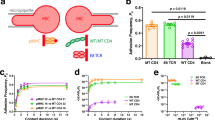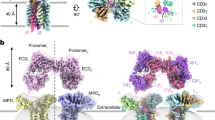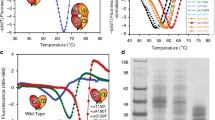Abstract
CD4 is a co-receptor in the cellular immune response. It increases the avidity of association between a T cell and an antigen-presenting cell by interacting with non-polymorphic portions of the complex between class II major histocompatibility complex (MHC) and T-cell receptor (TCR) molecules, and it contributes directly to signal transduction through its cytoplasmic association with the lymphocyte kinase Lck (ref. 1). CD4 also serves as the high-affinity receptor for cellular attachment and entry of the human immunodeficiency virus (HIV)2. The extracellular portion of CD4 comprises four immunoglobulin-like domains (D1–D4). This part of human CD4 (residues 1–369) has been characterized as a recom-binant soluble protein (sCD4)3,4, and crystal structures have been described for the human D1D2 fragment5,6 and for the rat D3D4 fragment7. We have now determined the structures of intact sCD4 in three crystal lattices. These structures have a hinge-like variability at the D1D2 to D3D4 junction that might be important in immune recognition and HIV fusion, and a common dimeric association through D4 domains. Dynamic light scattering measurements and chemical crosslinking of sCD4 corroborate dimerization at high protein concentration. We suggest that such dimers may have relevance as mediators of signal transduction hi T cells.
This is a preview of subscription content, access via your institution
Access options
Subscribe to this journal
Receive 51 print issues and online access
$199.00 per year
only $3.90 per issue
Buy this article
- Purchase on SpringerLink
- Instant access to full article PDF
Prices may be subject to local taxes which are calculated during checkout
Similar content being viewed by others
References
Weiss, A. & Littman, D. R. Signal transduction by lymphocyte antigen receptors. Cell 76, 263–274 (1994).
Lifson, J. D. & Engleman, E. G. Role of CD4 in normal immunity and HIV infection. Immunol. Rev. 109, 93–117 (1989).
Deen, K. C. et al. A soluble form of CD4 (T4) protein inhibits AIDS virus infection. Nature 331, 82–84 (1988).
Kwong, P. D. et al. Molecular characteristics of recombinant human CD4 as deduced from polymorphic crystals. Proc. Natl Acad. Sci. USA 87, 6423–6427 (1990).
Ryu, S.-E. et al. Crystal structure of an HIV-binding recombinant fragment of human CD4 Nature 348, 419–426 (1990).
Wang, J. et al. Atomic structure of a fragment of human CD4 containing two immunoglobulin-like domains. Nature 348 411–418 (1990).
Brady, R. L. et al. Crystal structure of domains 3 and 4 of rat CD4: relation to the NH2-terminal domains. Science 260, 979–983 (1993).
long, L. Combined molecular replacement. Acta Crystallogr. A 52, 782–784 (1996).
Ryu, S.-E., Truneh, A., Sweet, R. W. & Hendrickson, W. A. Structures of an HIV and MHC binding fragment from human CD4 as refined in two crystal lattices. Structure 2, 59–74 (1994).
Fleury, S. et al. Mutational analysis of the interaction between CD4 and class II MHC: class II antigen contact CD4 on a surface opposite the gp120-binding site. Cell 66, 1037–1049 (1991).
Sakihama, T., Smolyar, A. & Reinherz, F. L. Oligomerization of CD4 is required for stable binding to class II major histocompatibility complex proteins but not for interaction with human immunodeficiency virus go120. Proc. Natl Acad. Sci. USA 92, 6444–6448 (1995).
König, R., Shen, X. & Germain, R. N. Involvement of both major histocompatibility complex class II alpha and beta chains in CD4 function indicates a role for ordered oligomerization in T-cell activation. J. Exp. Med. 182, 779–787 (1995).
Moebius, U. et al. Human immunodeficiency virus gp120 binding C′C″ ridge of CD4 domain 1 is also involved in interaction with class II major histocompatibility complex molecules. Immunology 89, 12008–12012 (1992).
Moebius, U., Pallai, P., Harrison, S. C. & Reinherz, E. L. Delineation of an extended surface area on human CD4 involved in class II major histocompatibility complex binding. Proc. Natl Acad. Sci. USA 90, 8259–8263 (1993).
Huang, G., Fleury, S., Yachou, A., Hendrickson, W. A. & Sekaly, R. Analysis of the contact sites on the CD4 molecule with class II MHC molecule: co-ligand versus co-receptor function. J. Immunol. 158, 216–225 (1997).
Moir, S., Perreault, J. & Poulin, L. Postbinding events mediated by human immunodeficiency virus type I are sensitive to modifications in the D4-transmembrane linked region of CD4. J. Virol. 70, 8019–8028 (1996).
Healey, D. et al. Novel anti-CD4 monoclonal antibodies separate human immunodeficiency virus infection and fusion of CD4+ cells from virus binding. J. Exp. Med. 172, 1233–1242 (1990).
Lapham, C. K. et al. Evidence for cell-surface association between fusin and the CD4-gpl20 complex in human cell lines. Science 274, 602–605 (1996).
Wu, L. et al. CD4-induced interaction of primary HIV-1 gp120 glycoproteins with the chemokine receptor CCR-5. Nature, 384 179–183 (1996).
Ullrich, A. & Schlessinger, J. Signal transduction by receptors with tyrosine kinase activity. Cell 61, 203–212 (1990).
Yamaguchi, H. & Hendrickson, W. A. Structural basis for activation of human lymphocyte kinase Ick upon tyrosine phosphorylation. Nature 384, 484–489 (1996).
Kupfer, A., Singer, S. J., Janeway, C. A. & Swain, S. L. Coclustering of CD4 (L3T4) molecule with the T-cell receptor is induced by specific direct interaction of helper T cells and antigen-presenting cells. Proc. Natl Acad. Sci. USA 84, 5888–5892 (1987).
Kwong, P. D., Pound, A. & Hendrickson, W. A. Volume-specific amino acid analysis: a method for Za determination. J. Appl Crystallogr. 27, 504–509 (1994).
Jones, T. A., Zou, J. Y., Cowan, S. W. & Kjeldgaard, M. Improved methods for building models in electron density maps and the location of errors in those models. Acta Crystallogr. A 47, 110–119 (1991).
Brunger, A. T. X-PLOR: A System for X-ray Crystallography and NMR (Yale Univ. Press, New Haven, CT, 1992).
Harding, S. E. Determination of diffusion coefficients of biological macromolecules by dynamic light scattering. Methods Mol. Biol. 22, 97–108 (1994).
Kraulis, P. MOLSCRIPT—a program to produce both detailed and schematic plots of protein structures. J. Appl. Crystallogr. 24, 946–950 (1991).
Nicholls, A., Sharp, K. A. & Honig, B. Protein folding and association: insights from the interfacial and thermodynamic properties of hydrocarbons. Proteins 11, 281–296 (1991).
Evans, S. V. SETOR: hardware-lighted three-dimensional solid model representations of macromolecules. J. Mol. Graph. 111, 134–138 (1993).
Author information
Authors and Affiliations
Rights and permissions
About this article
Cite this article
Wu, H., Kwong, P. & Hendrickson, W. Dimeric association and segmental variability in the structure of human CD4. Nature 387, 527–530 (1997). https://doi.org/10.1038/387527a0
Received:
Accepted:
Issue Date:
DOI: https://doi.org/10.1038/387527a0
This article is cited by
-
HIV-1 Env trimers asymmetrically engage CD4 receptors in membranes
Nature (2023)
-
Structural basis of coreceptor recognition by HIV-1 envelope spike
Nature (2019)
-
Endocytic sorting motif interactions involved in Nef-mediated downmodulation of CD4 and CD3
Nature Communications (2017)
-
Dynamic electrophoretic fingerprinting of the HIV-1 envelope glycoprotein
Retrovirology (2013)
-
The sequence signature of an Ig-fold
Protein & Cell (2013)



